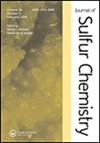亚硫酸酯作为二氧化硫-烷醇-三(羟甲基)氨基甲烷体系中相互作用的产物
IF 1.6
3区 化学
Q3 CHEMISTRY, MULTIDISCIPLINARY
引用次数: 0
摘要
本文章由计算机程序翻译,如有差异,请以英文原文为准。
Sulfite esters as products of the interaction in sulfur dioxide – alkanol – tris(hydroxymethyl)aminomethane systems
The reaction products formed in the SO2 – ROH – (HOCH2)3CNH2 (where R – CH3, C2H5, n-C3H7, i-C3H7, n-C4H9 and n-C5H11) systems were isolated and identified as: binary salt – ammonium O-methylsulfite [(HOCH2)3CNH3]+ [CH3OSO2]− (1); 1/1 charge transfer complex between diethyl sulfite (2) and tris(hydroxymethyl)aminomethane by S-N binding; polymorhps of zwitterionic internal salt – O-sulfite tris(hydroxymethyl)methylammonium (at R – n-C4H9 and n-C5H11); and its solvates with n-propanol 1/1 (3) and isopropanol 2/1. The structures of all synthesized products were confirmed by FT-IR, Raman, 1H NMR and 13C NMR spectrometry, and the structure of 1 and 3 was characterized by crystal X-ray diffraction studies as well.
求助全文
通过发布文献求助,成功后即可免费获取论文全文。
去求助
来源期刊

Journal of Sulfur Chemistry
CHEMISTRY, MULTIDISCIPLINARY-
CiteScore
4.10
自引率
9.10%
发文量
38
审稿时长
6-12 weeks
期刊介绍:
The Journal of Sulfur Chemistry is an international journal for the dissemination of scientific results in the rapidly expanding realm of sulfur chemistry. The journal publishes high quality reviews, full papers and communications in the following areas: organic and inorganic chemistry, industrial chemistry, materials and polymer chemistry, biological chemistry and interdisciplinary studies directly related to sulfur science.
Papers outlining theoretical, physical, mechanistic or synthetic studies pertaining to sulfur chemistry are welcome. Hence the target audience is made up of academic and industrial chemists with peripheral or focused interests in sulfur chemistry. Manuscripts that truly define the aims of the journal include, but are not limited to, those that offer: a) innovative use of sulfur reagents; b) new synthetic approaches to sulfur-containing biomolecules, materials or organic and organometallic compounds; c) theoretical and physical studies that facilitate the understanding of sulfur structure, bonding or reactivity; d) catalytic, selective, synthetically useful or noteworthy transformations of sulfur containing molecules; e) industrial applications of sulfur chemistry; f) unique sulfur atom or molecule involvement in interfacial phenomena; g) descriptions of solid phase or combinatorial methods involving sulfur containing substrates. Submissions pertaining to related atoms such as selenium and tellurium are also welcome. Articles offering routine heterocycle formation through established reactions of sulfur containing substrates are outside the scope of the journal.
 求助内容:
求助内容: 应助结果提醒方式:
应助结果提醒方式:


